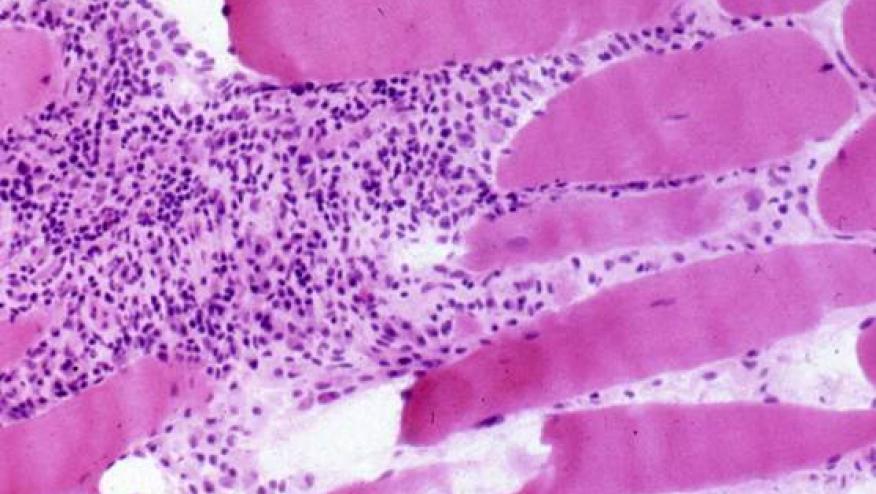BSR Guideline on Idiopathic Inflammatory Myopathy Save

The British Society of Rheumatology (BSR) has published evidence-based guidelines for idiopathic inflammatory myopathy (IIM) affecting juvenile and adult-onset disease. This rare condition has an estimated prevalence of 5-15 per 100,000 persons.
The guideline committee that reviewed the literature and developed consensus using TAGREEII (Appraisal of Guidelines for Research and Evaluation II) methodology included 11 adult rheumatologists. 6 paediatric rheumatologists, 2 adult neurologists, a paediatric neurologist, nurse, pharmacist, dermatologists, paediatric dermatologist, 3 physiotherapists, and 4 patient representatives.
A total of 213 papers were used to form recommendations. The strength of recommendation was graded as strong = 1, or conditional = 2. Recommendation evidence was rated as high (A), moderate (B), low (C) or very low (D), according to GRADE methodology. Thus each recommendation was scored by: Strength, Evidence and consensus (e.g. 1, B, 100%)
For full details on recommendations, please see the citation link at the end of this article.
Highlight recommendations for specific clinical questions included:
How to Treat Skeletal Muscle Inflammation (myositis) ?
- High dose glucocorticoids (1, B, 100%).
- Adult-specific: Oral prednisolone at a dose of 0.5–1 mg/kg/day, usually 40–60 mg daily (1, B, 100%)
- Paediatric-specific: Oral prednisolone at a dose of 1–2 mg/kg/day or intravenous methylprednisolone pulses 30 mg/kg/day, maximum 1 g daily i.v. dose is recommended (1, B, 100%)
- DMARDS should be used to reduce muscle inflammation, achieve remission and reduce steroid burden (1, C, 100%)
- Adult-specific. Methotrexate, azathioprine, tacrolimus, ciclosporin, and mycophenolate mofetil are to be considered (2, C, 96%)
- Paediatric-specific. Early, complete control of muscle weakness and inflammation should be sought in juvenile-onset IIM, with the aim of improving outcomes and reducing disease-related complications (1, B, 100%).
- A combination of high dose glucocorticoid and methotrexate should be used as first-line treatment in most cases (1, B, 100%)
- Methotrexate is preferred over ciclosporin, as this has a more favourable side effect profile (1, B, 100%)
- Mycophenolate mofetil may also be considered to improve skin and muscle disease (2, C, 100%)
- Intravenous immunoglobulin should be considered as a treatment of severe and/or refractory muscle inflammation (1, B, 100%)
- Refractory IIM - consider rituximab, cyclophosphamide or abatacept
- Exercise is safe and effective for people with IIM and can improve quality of life and function
How to Treat IIM-related Skin Manifestations ?
- Steroids and DMARDs as noted above are 1st line
- Refractory disease; Rituximab or IVIG
- Sun avoidance and regular use of high factor broad spectrum sun cream
How to Manage IIM-related Interstitial Lung Disease (ILD) ?
- Paediatric-specific. Routinely assess PFTs/DLCO, as pulmonary function abnormalities may be asymptomatic (1, B, 100%)
- Adult-specific. Interstitial lung disease should be screened for in high-risk patients (1, B, 100%)
- In the treatment of rapidly progressive interstitial lung disease (RP-ILD):
- Induction therapy with high dose steroids is to be considered (2, C, 96%)
- Ciclosporin or tacrolimus, alongside steroids, to be considered in patients with RP-ILD (2, C, 96%)
- Cyclophosphamide or rituximab therapy is to be considered early, potentially as part of the induction regimen (2, C, 96%)
- Adult-specific. In the treatment of chronic IIM-associated interstitial lung disease:
- Immunosuppression using steroids with or without a single DMARD (azathioprine, ciclosporin, tacrolimus, mycophenolate) is to be considered (2, C, 100%).
- Rituximab or cyclophosphamide is to be considered in treatment-resistant patients (2, C, 100%)
Who should have Cancer Screening with an IIM?
- Paediatric-specific. Routine screening for cancer is not warranted in juvenile-onset IIM (1, B, 100%)
- Adult-specific. The risk of cancer should be considered in all patients and screening should be particularly considered in those with the following risk factors (1, B, 100%):
- Older age at onset
- Male gender
- Dysphagia
- Cutaneous necrosis
- Resistance to immunosuppressive therapy
- Rapid disease onset
- Positive anti-TIF1-γ autoantibodies
- Positive anti-NXP2 autoantibodies
- Negative for known myositis-specific abs
Other clinical questions covered in this guideline included:
- What management steps should be taken to reduce fracture risk in people with IIM?
- What key prognostic and management factors should be considered for children with IIM?
- Is autoantibody testing useful in people with IIM?
- How should IIM treatment during pregnancy and the breastfeeding period be amended?
- How should IIM-related cardiovascular disease be assessed for and treated?
- How should IIM-related dysphagia be screened for and managed?
- How should quality of life and mental wellbeing be assessed and treated in people with IIM?









If you are a health practitioner, you may Login/Register to comment.
Due to the nature of these comment forums, only health practitioners are allowed to comment at this time.